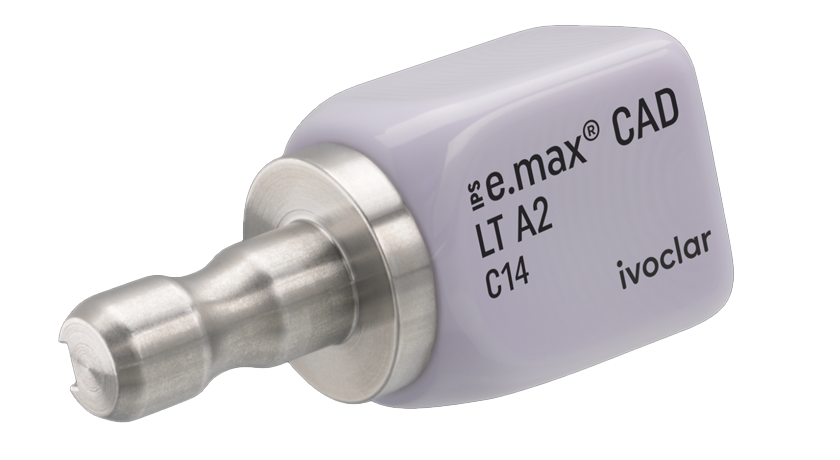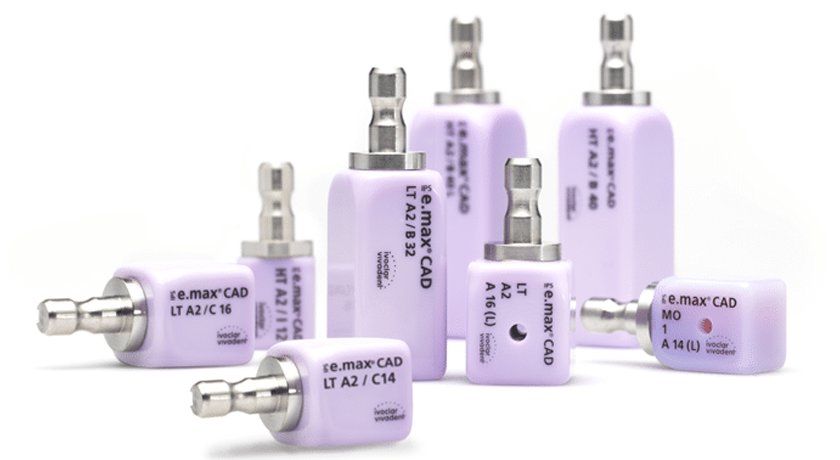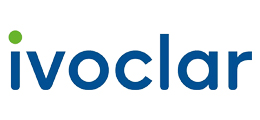IPS e.max CAD CEREC Block LT C14 / 5
by Ivoclar
IPS e.max CAD CEREC Block LT C14 / 5
Lithium disilicate glass-ceramics (LS2)
IPS e.max® CAD is the best-selling glass-ceramic[1] worldwide. The material enables the efficient fabrication of full-contour restorations. It is distinguished by its flexibility, versatile field of applications and processing options and its high strength of 530 MPa[2].
Both its aesthetic properties and durability have been confirmed in everyday clinical practice[3-5].
Processing options:
“Blue” restorations can be:
Polished and crystallised
Glazed and crystallised in a single step
Stained, glazed and crystallised in a single step
Types of restorations:
Minimally invasive crowns (1 mm)[6]
crowns
Three-unit bridges (up to the second premolar as the terminal abutment)
Implant-supported hybrid abutment restorations (hybrid abutments[7], hybrid abutment crowns) – Veneers and occlusal veneers
Inlays, onlays, partial crowns
Benefits:
Excellent aesthetics and high flexural strength of 530 MPa[2]
97.2% survival rate of posterior crowns over a period of 10 years[8]
Efficient grinding and crystallisation of posterior crowns in only 19:17 minutes[9]
Broad spectrum of restorations for your chairside CAD/CAM applications
10-year guarantee
Suitable for conventional, adhesive or self-adhesive cementation techniques
Block sizes[7]:
6 (I12, C14, C16, B32, B40 and B40 L) and 2 abutment block sizes (A14, A16)
Translucency levels[7]:
4 levels and 2 Impulse blocks (HT - High Translucency, MT - Medium Translucency, LT - Low Translucency, MO - Medium Opacity)
Shades[7]:
Comprehensive range of shades: in A-D and BL shades (the range of shades varies depending on the translucency level), see page 60-65.
Authorised CAD/CAM systems:
Ivoclar:
PrograMill® PM3 / PM5 / PM7
Zenotec® Select Hybrid
Amann Girrbach:
Ceramill® mikro ic,
Ceramill® motion 2 / motion 3 /drs
Ceramill® matik
Planmeca:
PlanMill® 30 S / 40 / 40 S
Dentsply Sirona:
inLab® MC XL / MC X5
CEREC® MC / MC X / MC XL / Primemill
[1] Based on global sales figures.
[2] Average biaxial flexural strength; outcome after more than 10 years of ongoing quality testing, R&D Ivoclar, Schaan.
[3] Fasbinder D. J et al., Study report, 2017b.
[4] Rauch A et al., Clin. Oral Investig. 2018, 22, p. 1763-1769.
[5] Boldt J, Spitznagel F. A, Dtsch. Zahnaerztl. Z. 2017, 72 (4), p. 319-325.
[6] Long-term clinical evidence and the material’s high strength allows the recommendation for crowns with a minimum layer thickness of 1mm in combination with an adhesive cementation method.
[7] The offering varies, depending on the CAD/CAM system being used.
[8] The survival rate of monolithic IPS e.max CAD posterior crowns was evaluated with the Kaplan-Meier method. The failure rate refers to technical failures such as fractures and chipping, R&D Ivoclar, Schaan.
[9] Average grinding time of three posterior crowns, 08:07 minutes (CEREC Primemill, fast grinding mode), followed by superspeed crystallisation in the Programat CS6, 11:10 minutes (HT, MT, LT / glaze spray or polishing technique), maximal two restorations, R&D Ivoclar, Schaan.
CEREC®, inLab®, PlanMill® and Ceramill® are not registered trademarks of Ivoclar Vivadent AG.
Video
Contact
25 Cleg Street Artarmon NSW 2064




